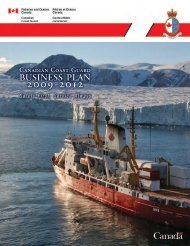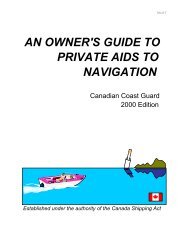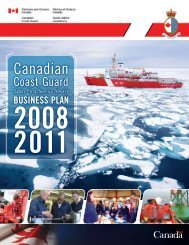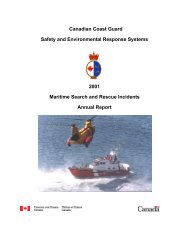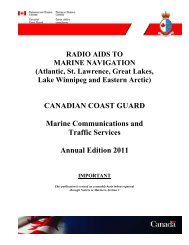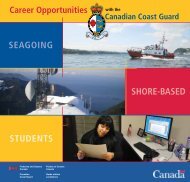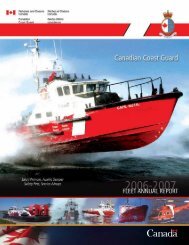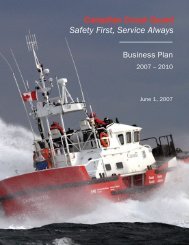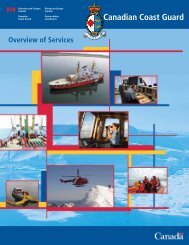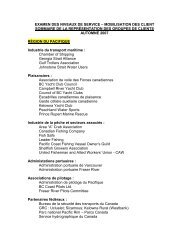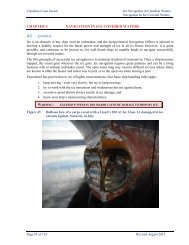PART 4 - Canadian Coast Guard
PART 4 - Canadian Coast Guard
PART 4 - Canadian Coast Guard
Create successful ePaper yourself
Turn your PDF publications into a flip-book with our unique Google optimized e-Paper software.
Ship Station (Radio) Regulations, 1999<br />
Ships ≥ 20m and certified to carry >12 passengers, or ships ≥300gt<br />
All other ships<br />
Italics represent new requirements to be complied with by April 1 st , 2001, unless otherwise indicated.<br />
• Requirements for Safety Convention ships are not shown as they must comply with the Safety Convention<br />
• Requirements for ships on inland voyages and minor waters voyages are not shown since there are no new requirements<br />
• Regulations do not apply to a pleasure yacht not carrying a master or crew for hire, or a tow-boat in a booming ground<br />
Equipment<br />
VHF Radio with DSC<br />
(SSRR)<br />
Inmarsat Ship Earth Station with EGC,<br />
and MF Radio with DSC,<br />
Or<br />
MF/HF Radio with DSC and NBDP<br />
(SSRR)<br />
NAVTEX Receiver<br />
(no change to current requirement-SSRR)<br />
EPIRB (float-free)<br />
(SSRR)<br />
Radar Transponder(s) (SARTs)<br />
(SSRR, Life Saving Equipment<br />
Regulations, Large Fishing Vessel<br />
Inspection Regulations, and Small Fishing<br />
Vessel Inspection Regulations)<br />
Survival Craft VHF Portable Radio<br />
(Life Saving Equipment Regulations,<br />
Large Fishing Vessel Inspection<br />
Regulations)<br />
Reserve Source of Energy<br />
Sea Area A1<br />
or<br />
Sea Area A3<br />
Sea Area A4<br />
VHF Area<br />
Yes<br />
-unless ship operates within a VTS Zone, then will have until January 31, 2003, or until the sea area A1<br />
is completed, whichever is latest<br />
Yes<br />
- by February 1, 2003, or after sea area A1 completed, whichever is latest<br />
• ships ≥8m in length and of closed construction,<br />
• ships carrying >6 passengers, and<br />
• tow boats<br />
-exempted are ships on a home-trade voyage, class IV in a VTS Zone<br />
-current VHF radiotelephone provisions remain in effect until then<br />
no<br />
Yes<br />
(EGC required only if<br />
outside NAVTEX range)<br />
no<br />
Yes<br />
MF/HF option only<br />
no Yes no<br />
no<br />
Yes<br />
no<br />
• if ≥ 150gt tow boat<br />
• if ≥ 300gt cargo ship<br />
• if ≥ 24m fishing, or<br />
• if passenger ship<br />
Yes<br />
Yes<br />
• if ≥20m (and beyond home trade IV voyage)<br />
• if tug >5gt and 50 miles long and >2 miles from shore<br />
• if ≥ 15gt and go beyond home-trade III voyage limits i.e., 20 miles from shore by April 1, 2001<br />
• if ≥ 8m and go beyond home-trade III voyage limits on April 1, 2002<br />
(Note: EPIRB does not have to be float-free if less than 15gt)<br />
-exempted are ships on home-trade voyages, class IV or minor waters voyages<br />
no<br />
Yes<br />
2 are required, unless ship is certified to carry ≤ 12<br />
passengers and is HTII voyages; but, can continue to carry 2 Class II EPIRBs instead until<br />
one of the batteries expire.<br />
Yes<br />
3 are required, unless ship is certified to carry ≤ 12 passengers and is 12 passengers and<br />
is >5gt<br />
Yes<br />
Yes<br />
if ship is ≥20m, is carrying more than 6 passengers, or is a tow-boat<br />
DSC: digital selective calling EGC: enhanced group calling NBDP: narrow band direct printing<br />
Additional requirements: emergency procedures card, operating and routine maintenance manuals, consumable spare parts,<br />
radio publications, time piece, weather facsimile (Arctic), spare antennas (some ships ≥20m).<br />
4-17



